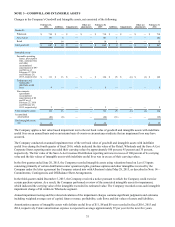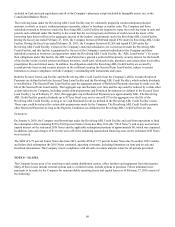Albertsons 2016 Annual Report Download - page 73
Download and view the complete annual report
Please find page 73 of the 2016 Albertsons annual report below. You can navigate through the pages in the report by either clicking on the pages listed below, or by using the keyword search tool below to find specific information within the annual report.71
as a cash flow hedge and are determined to be highly effective, changes in the fair value of these instruments are recognized in
Accumulated other comprehensive loss in the Consolidated Balance Sheets reclassified into earnings in the period in which the
hedged transaction affects earnings. Hedging ineffectiveness, if any, is recognized in earnings in the Consolidated Statements of
Operations.
The Company’s limited involvement with diesel fuel derivatives is primarily to manage its exposure to changes in energy prices
utilized in the shipping process. These contracts are economic hedges of price risk and are not designated or accounted for as
hedging instruments for accounting purposes. Changes in the fair value of these instruments are recognized in earnings in the
Consolidated Statements of Operations.
In addition, the Company enters into energy commitments for certain amounts of electricity and natural gas purchases that it
expects to utilize in the normal course of business. Changes in the fair value of these purchase obligations are not recognized in
earnings until the underlying commitment is utilized in the normal course of business.
Stock-Based Compensation
Stock-based compensation expense is measured by the fair value of the award on the date of grant, net of the estimated
forfeiture rate. The Company uses the straight-line method to recognize stock-based compensation expense over the requisite
service period related to each award.
The fair value of stock options is estimated as of the date of grant using the Black-Scholes option pricing model using Level 3
inputs. The estimation of the fair value of stock options incorporates certain assumptions, such as the risk-free interest rate and
expected volatility, dividend yield and life of options. Restricted stock awards and units are recorded as stock-based
compensation expense over the requisite service period based on the market value of the Company's common stock on the date
of grant.
Income Taxes
Deferred income taxes represent future net tax effects resulting from temporary differences between the financial statement
amounts and tax bases of assets and liabilities and are measured using enacted tax rates in effect for the year in which the
differences are expected to be settled or realized. See Note 9—Income Taxes for the types of differences that give rise to
significant portions of deferred income tax assets and liabilities. Deferred income tax assets are reported as a noncurrent asset
or liability based on the classification of the related asset or liability or according to the expected date of reversal.
The Company is currently in various stages of audits, appeals or other methods of review with authorities from various taxing
jurisdictions. The Company establishes liabilities for unrecognized tax benefits in a variety of taxing jurisdictions when, despite
management’s belief that the Company’s tax return positions are supportable, certain positions may be challenged and may
need to be revised. The Company adjusts these liabilities in light of changing facts and circumstances, such as the progress of a
tax audit. The Company also provides interest on these liabilities at the appropriate statutory interest rate, and accrues penalties
as applicable. The Company recognizes interest related to unrecognized tax benefits in Interest expense and penalties in Selling
and administrative expenses in the Consolidated Statements of Operations.
Common and Treasury Stock
Concurrent with the execution of the Stock Purchase Agreement in fiscal 2013, the Company entered into a Tender Offer
Agreement (the “Tender Offer Agreement”) with Symphony Investors LLC, which was owned by a Cerberus Capital
Management, L.P. (“Cerberus”)-led investor consortium (“Symphony Investors”), and Cerberus, pursuant to which, upon the
terms and subject to the conditions of the Tender Offer Agreement, and contingent upon the NAI Banner Sale, Symphony
Investors tendered for up to 30 percent of the issued and outstanding common stock of the Company at a purchase price of
$4.00 per share in cash (the “Tender Offer”). Approximately 12 shares were validly tendered, representing approximately 5.5
percent of the issued and outstanding shares at the time of the Tender Offer expiration on March 20, 2013. All shares that were
validly tendered and not properly withdrawn were accepted as tendered in accordance with the terms of Tender Offer.
In addition, pursuant to the terms of the Tender Offer Agreement, on March 21, 2013, the Company issued approximately 42
additional shares of common stock (representing approximately 19.9 percent of the outstanding shares prior to the share
issuance) to Symphony Investors at the Tender Offer price per share of $4.00, resulting in $170 in cash proceeds to the
Company, which brought Symphony Investors' ownership percentage to 21.2 percent after the share issuance. On April 28,
2015, Symphony Investors distributed its shares of Supervalu common stock to its members on a pro rata basis. As a result,
Cerberus Iceberg LLC received 21 shares, which were beneficially owned by Mr. Stephen Feinberg, which subsequently sold
all or a portion of these shares. No other member of Symphony Investors received more than five percent of the Company’s
issued and outstanding common stock.
























